Research Activities
Joint International Research
The NRICH as the only comprehensive national research institution for cultural heritage in South Korea, has been making significant, noteworthy discoveries regarding the restoration of the “Network for Heritages of Ancient Culture Korea” by carrying out joint excavations and research projects with Russia, Mongolia, and few Central Asian countries since 2000. Joint international excavations are a purposeful endeavor for securing research materials needed to restore not only our history but also the ancient cultural network and establishing cooperative relationships internationally through research of common human cultural heritage and networking.
Results of Joint Research Projects with Russia, Mongolia and Kazakhstan will be briefly introduced in honour of the Joint Excavation/Research Projects conducted up to the present.
KOR-RUS Joint Excavation Research of the Amur River Valley (2000 – 2009)
Institutions: NRICH - Institute of Archaeology and Ethnology, Siberian Branch of Russian Academy of Sciences
The archaeological excavations in Khabarovsk Krai at the Amur basin and Primorsky Krai, where Okjeo, Goguryeo and Balhae – parts of Korean history - were located, led by a Joint KOR-RUS research team have made important discoveries related to the studies ranging from the Neolithic to the North and South States Period (Balhae) ever since 2000.
The Suchu Island Site at the lower Amur River (2000 – 2002), which have shed light on the exchange relationships of Korean east coast area in the Neolithic; the Bulochka Site in Primorsky Krai (2003 – 2005), which have yielded early Iron Age (Okjeo) dwellings and ondol; and the Balhae and Malgal Sites at the middle course of the Amur (2007 – 2009) have been excavated. Various archaeological materials including 57 dwellings and tombs, and some 60,000 artefacts were discovered during these investigations and three series of research reports were published.
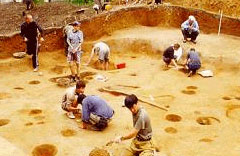 Excavation at the Suchu Island
Excavation at the Suchu Island 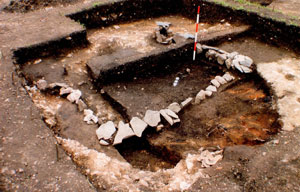 Ondol-floor heating system, Bulochka Site
Ondol-floor heating system, Bulochka Site 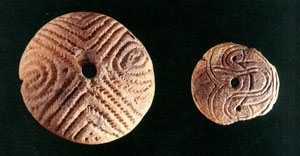 Disk-shaped earthenware objects,
Disk-shaped earthenware objects,Suchu Island
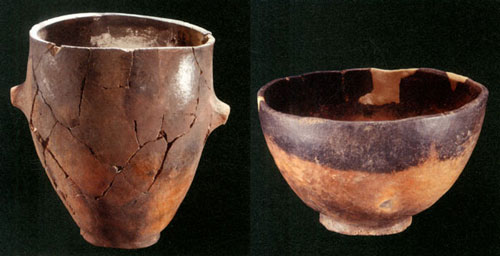 Earthenware, Bulochka Site
Earthenware, Bulochka Site KOR-RUS Joint Excavation Research of the Balhae Fortifications, Primorsky Krai (2008 – 2019)
Institutions: NRICH – Institute of History, Archaeology and Ethnography of the Peoples of Far-East, Far East Branch of the Russian Academy of Sciences
Excavations of Balhae Fortifications have launched in 2008, in order to focus on research of Balhae (698 – 926), a great empire that was formed across parts of China, Primorsky Krai and North Korea, which was also called the ‘Flourishing Land in the East’ in 9th century Northeast Asia.
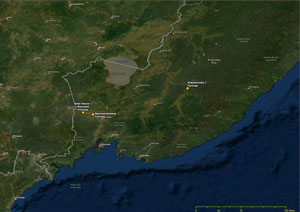 Locations of the investigations in the Primorsky area, Russia
Locations of the investigations in the Primorsky area, Russia Excavations of the Koksharovka-1 Fortress in Primorsky Krai (2008 – 2014)
The flood plain at the upper Ussuri River in Chuguyevka and Koksharovka River within Primorsky Krai, Russia
-
- Seven building sites with “呂”-shaped partial under-floor heating facilities - a tradition inherited from Goguryeo – and walls were discovered, alongside artefacts such as golden and silver accessories, plain roof tiles, iron caldron and especially, a cylindrical pottery stand, which was unprecedented in the Primorsky area.
- Construction time and techniques of the fortress were excavated and a stone building site for sacrificial rites, which is unique in Primorsky Krai was uncovered.
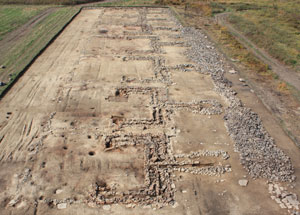 Large building site
Large building site 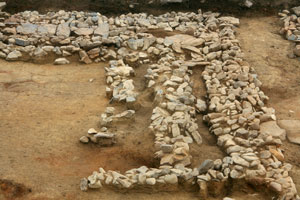 Ondol, east of Large Building Site No. 2
Ondol, east of Large Building Site No. 2 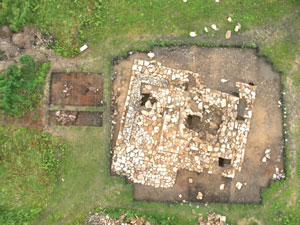 Stone platform structure
Stone platform structure 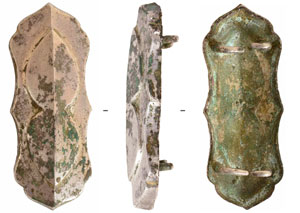 Silver buckle adornment
Silver buckle adornment 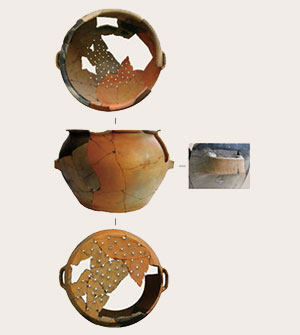 Steamer
Steamer 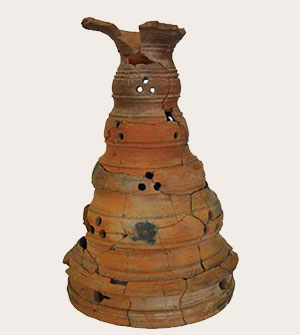 Cylindrical pottery stand
Cylindrical pottery stand 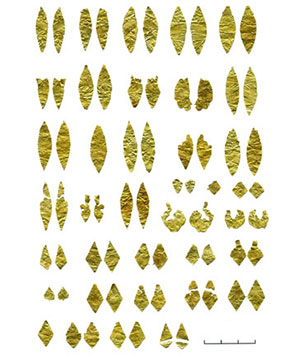 Goldenwares
Goldenwares Excavations of the Sinel’nikovo-1 Mountain Fortress (2015 – 2016)
Vicinity of Shinel’nikovo village in Oktyabrsky District, west to Ussuriysk in Primorsky Krai, Russia
-
- Early stages of Balhae’s territorial expansion were ascertained.
- The 700m long wall was built with the common Balhae fortress construction method with stonework and earth for backfilling.
- Fragments of Malgal pottery, wheel-made pottery vessel presumed to be of Balhae origin, Balhae earthen cube-shaped object, etc. were unearthed.
- Radiocarbon dating (C14) test indicated that the fortress was constructed in the late 7th century, which was the early Balhae Period.
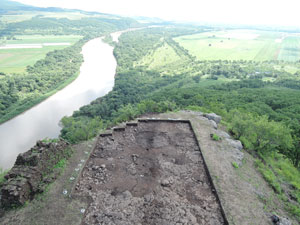 View of the Site
View of the Site 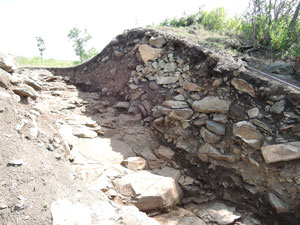 Excavation of the southeastern wall
Excavation of the southeastern wall 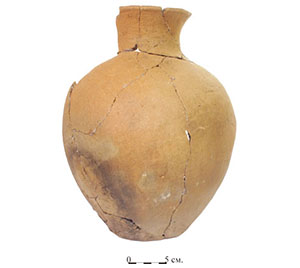 Wheel-made pottery vessel
Wheel-made pottery vessel  Balhae cube-shaped object
Balhae cube-shaped object Excavations of the Starorechenskoe Fortress (2017 – 2019)
Razdolnaya riverside in the vicinity of Starorechenskoe village, Oktyabrsky District in Primorsky, Russia
-
- Panchuk wall, which is mound layering construction technique of stacking different soil in alternation, was excavated. Various Balhae remains and artefacts were discovered such as pit-style stone-lined storage (presumably ice storage), gate and road facility covered with river pebbles, tripod vessel, wheel-made pottery vessel, finger-tip impressed convex roof tile, bronze earpick, and animal and fish bones.
- This site is recognized as the most ideal archaeological site for the research of Late Balhae’s life
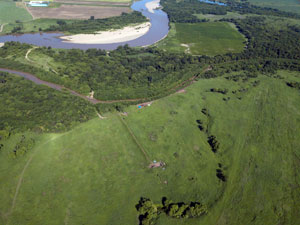 View of the site
View of the site 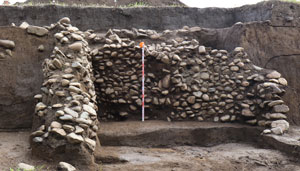 it-style stone-lined storage (presumed ice storage)
it-style stone-lined storage (presumed ice storage) 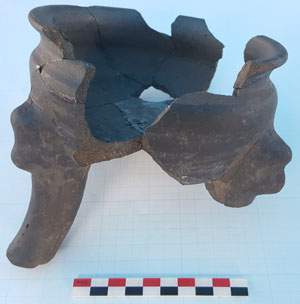 Tripod vessel
Tripod vessel 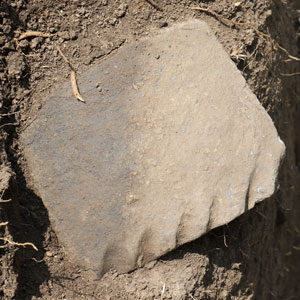 Finger-tip impressed concave eave-end roof tile
Finger-tip impressed concave eave-end roof tile  Cross section of the panchuk constructed southern wall
Cross section of the panchuk constructed southern wall Research of Ancient Eurasia’s Cultural Network
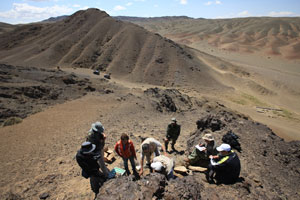
Investigation of the cave tomb in Govi-Altai, Mongolia in 2009
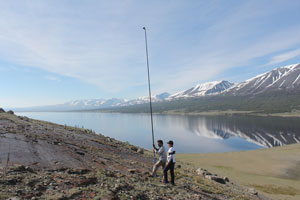
investigation of the Govi-Altai petroglyph, Mongolia in 2015
The Eurasian Continent, encompassing Europe and Asia as the largest continent accounting for some 40% of the Earth’s land surface has been the venue of rise and fall of various ethnic groups and cultures.
Korea is located at the eastern edge of the Eurasian Continent and therefore demonstrates aspects of varied cultural exchange activities. The globalization of the ‘K-Culture’, which has been drawing a lot of attention recently in that respect, might be the modern reflection of such Eurasian cultural exchanges of the past.
The National Research Institute of Cultural Heritage of Republic of Korea has been pursuing the project ⌈Ancient Eurasia’s Stone-Mound-Tomb-Culture Network⌋ in order to inquire into the formation of the ancient Korean culture and exchange activities. Joint investigations have been carried out since 2015 along with the research institutions of Central Asian countries such as Kazakhstan and Mongolia for this purpose.
Meanwhile, the excavation of the Kara Tepe Buddhist Site (2011 – 2014) in southern Uzbekistan as part of an effort to ascertain the ancient Buddhist cultural exchange activities of Korea within Eurasia shed light on the values of the archaeological site, which has been the primary base for Buddhism in Central Asia.
Also, international research infrastructure needed for the development of history of cultural exchanges, such as the Silk Road and the Steppe Route, is being accumulated through investigations like distribution status surveys on 522 sites in the area of Govi-Altai, Mongolia (Bronze Age – Turkic Period), 134 Kurgan sites in Zhetysu in Almaty and East Kazakhstan, Kazakhstan.
Joint excavations of the Ancient Tombs in Katartobe, Kazakhstan (2015 – 2017)
Institutions:
National Research Institute of Cultural Heritage, Republic of Korea – Institute of Archaeology of A. Kh. Margulan and the National Museum of the Republic of Kazakhstan
Location: Southeastern Zhetysu, Almaty (2015 – 2018)
- 1. Geophysical prospection and aerial photogrammetry
- 1.1. Over 50 burial/ritual structures of different periods confirmed.
- 1.2. Rectangular and circular Kurgan burials(Dimensions: d: 10 - 60m, h: 1 – 4m.) are aligned in the north-south direction (in four groups).
- 2. Major discoveries of the excavations (of total of Five Kurgan burials investigated)
- 2.1. Multiple main burials are located beneath Saka Period mounds (5th to 3rd century B.C.; collective burial can imply simultaneous deaths by war or disease, or burial in sacrifice).
- 2.2. Funerary rituals from the time of the burial were confirmed (burial goods, animal bones, burnt wooden outer coffin covers, etc
- 3. Interdisciplinary research about the findings
- 3.1. Radiocarbon dating (¹⁴C)
-Two identical charcoal samples sent to two analysis agencies ascertained the Saka Period (5th to 2nd century B.C.).
- 3.2. Analysis of human skeletal remains
- Physical anthropological analysis: heights of the buried male: 170 – 180㎝, female: 170㎝.
- Restoration of facial muscles on the skulls: European Caucasoids
- Stable isotope analysis of collagen extracted from the bones (inquiry of source of nutrient): : diet consisting primarily of meat and dairy, with small amounts of wheat, oat, millet, corn, etc.. - 3.3. Analysis of faunal remains (determination of physical traces such as weathering, plant roots, tools, heating, etc.)
- Funerary rituals with “sacrifice complex” including domesticated horses, dogs, sheep and cows.
- Sheep and horses were sacrificed for the dead as “funerary food”. - 3.4. Natural scientific analysis of the pottery objects
- Each nomadic group used materials from separate clay sources.
- Burnt bones, wet compost, organic solution and more were added to the clay.
- Calcined with oxidation (open-air, 700°C or less).
- 3.1. Radiocarbon dating (¹⁴C)
- 4. Production and application of digital contents
- - UAV aerial photography, generation of 360° panoramic images and service (http://vrNational Research Institute of Cultural Heritage.kr).
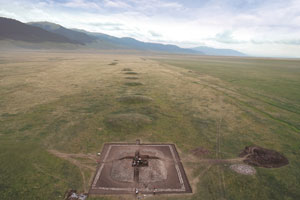 Tomb No. 14 of Group 4
Tomb No. 14 of Group 4 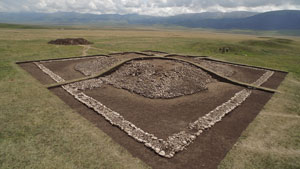 Tomb No. 1 of Group 2
Tomb No. 1 of Group 2 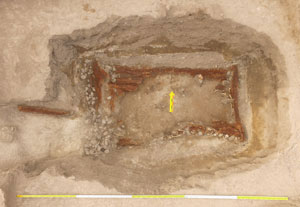 Main burial, Tomb 14 of Group 4
Main burial, Tomb 14 of Group 4 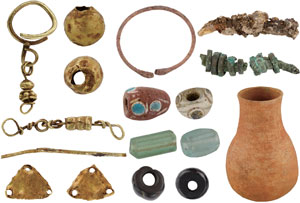 Artefacts(Tomb No. 1 of Group 2)
Artefacts(Tomb No. 1 of Group 2) 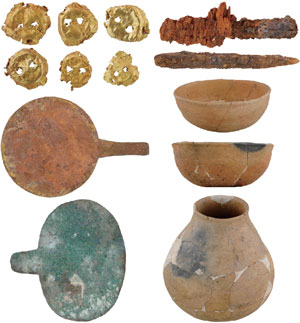 Artefacts(Tomb No. 8 of Group 2)
Artefacts(Tomb No. 8 of Group 2)  Facial restoration of the skull from the main burial, Tomb No. 10-1 of Group 4 (male)
Facial restoration of the skull from the main burial, Tomb No. 10-1 of Group 4 (male) Joint Excavations of the Ancient Tombs of Shiveet Khairkhan in Altai, Mongolia (2016 – 2018)
Institutions:
National Research Institute of Cultural Heritage of the CHA, Republic of Korea – Institute of History and Archaeology of the Mongolian Academy of Sciences
Location: Tsengel, Bayan-Ölgii, Mongolia
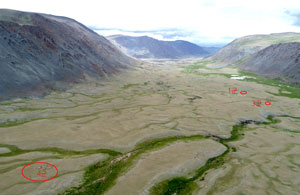 View of the site
View of the site 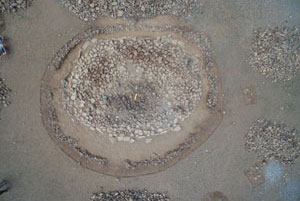 Boundary stones and burial pit exposed, Pazyryk Tomb No. 3
Boundary stones and burial pit exposed, Pazyryk Tomb No. 3 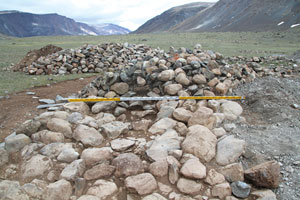 Pazyryk Tomb No. 3
Pazyryk Tomb No. 3 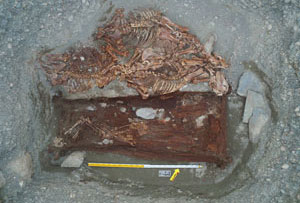 Wooden outer coffin, Tomb No. 3
Wooden outer coffin, Tomb No. 3 - 1. Major discoveries of the excavations of the Pazyryk burials (4th to 2nd century B.C.)
- 1.1. The eastern boundary of the Pazyryk Culture was determined. (2500m above sea level)
- 1.2. The stone mounds measure about 9 – 15m in diameters; vertical and horizontal partitions were confirmed at some of the mounds (Tombs Nos. 3, 8)
- 1.3. Various materials were confirmed to have been applied for the main burials formed around the same time; wooden coffin + wooden outer coffin, log coffin, stone coffin, and the likes.
- 1.4. One set of horse skeletal remains were discovered from the stone coffin of Tomb No. 6, one set of human and three sets of horse skeletal remains were unearthed from the wooden coffin, and large bronze nails were lodged in the wooden outer coffin of Tomb No. 3 (new type of discovery in terms of burial rites in Mongolian Altai)
- 1.5. Evidence of death (hole) caused by war (tool/weapon) on the crown of the skull of the buried of Tomb No. 9 was verified.
- 1.6. Wooden accessories and pottery items with inexperienced patterns, shapes and gold leaves, bronze nails and horses buried in sacrifice display dissimilar aspects to other Pazyryk burials of Mongolian Altai.
- 1.7. The head directions of the buried all face northeast, which is specific to this region (presumed to be regional aristocrats or commoners)
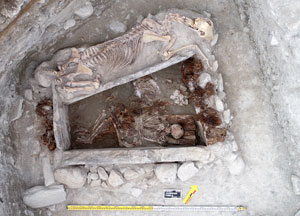 Stone coffin and wooden cover, Tomb No. 9
Stone coffin and wooden cover, Tomb No. 9 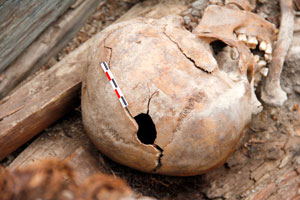 Hole in the crown of the human skull, Tomb No. 9
Hole in the crown of the human skull, Tomb No. 9 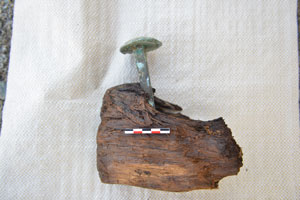 Bronze nail, Tomb No. 3
Bronze nail, Tomb No. 3 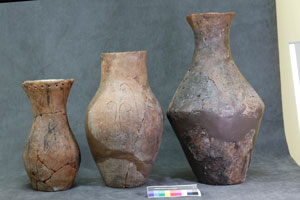 Pottery objects from Pazyryk burials
Pottery objects from Pazyryk burials 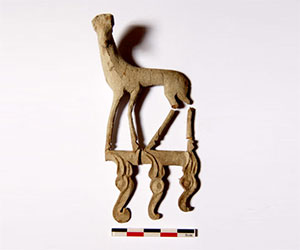 Wooden adornment, Tomb No. 9
Wooden adornment, Tomb No. 9 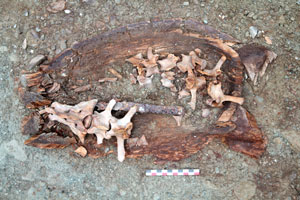 Discoveries from underneath the log coffin, Tomb No. 7
Discoveries from underneath the log coffin, Tomb No. 7 - 2. Major discoveries of the excavations of the Xianbei burials (1st to 3rd century)
- 2.1. Extensive research materials such as clothing styles and burial methods (head directions are northwest or northeast but facing north) of the Xianbei nomads of the Altai were secured.
- 2.3. Diverse constructions methods such as installation of low stone mounds and double burial surrounding stones.
- 2.4. Silk, cloth, fabric and silver accessories attached to the fabric were unearthed alongside a mummified corpse.
- 2.5. Only a small beads necklace was exhumed in terms of artefacts. Three cowry shells found from Tomb No. 3 (inhabiting the warm current of Southeast Asia – South coast of Korea – Japan’s Kuroshio) particularly proves the active exchanges between various groups of nomads.
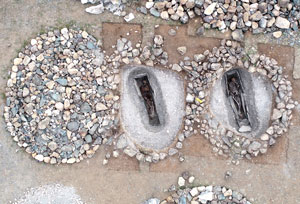 Stone Xianbei Tombs Nos. 4, 5, 6
Stone Xianbei Tombs Nos. 4, 5, 6 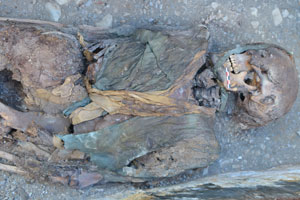 Clothing item, Tomb No. 4
Clothing item, Tomb No. 4 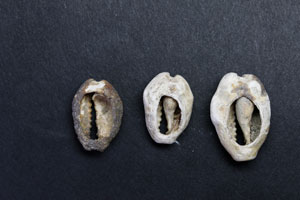 Cowry shells next to a skull, Tomb No. 3
Cowry shells next to a skull, Tomb No. 3 

